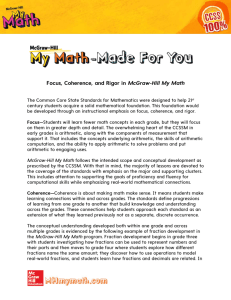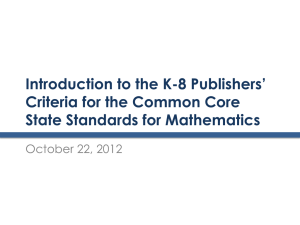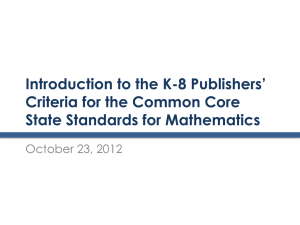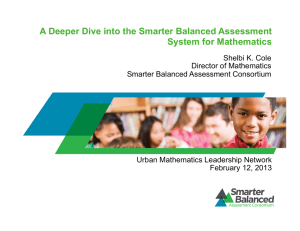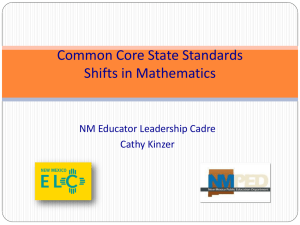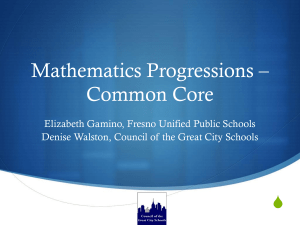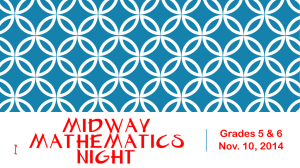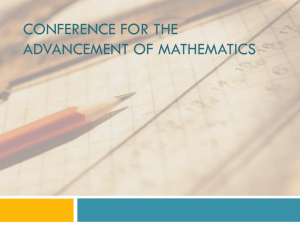K-5 CCSS Math Shifts
advertisement
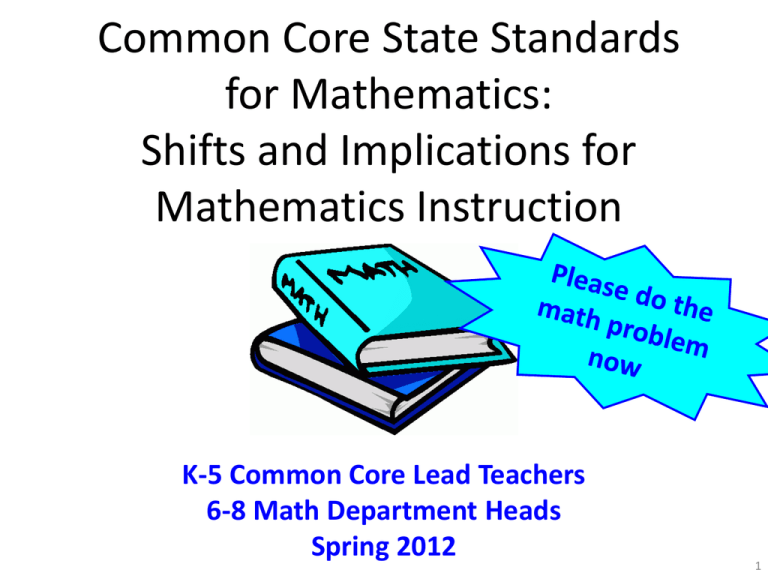
Common Core State Standards for Mathematics: Shifts and Implications for Mathematics Instruction K-5 Common Core Lead Teachers 6-8 Math Department Heads Spring 2012 1 The Three Shifts in Mathematics • Focus strongly where the standards focus • Coherence: Think across grades and link to major topics within grades • Rigor: Require conceptual understanding, fluency, and application 2 Shift One: Focus strongly where the Standards focus • Significantly narrow the scope of content and deepen how time and energy is spent in the math classroom • Focus deeply only on what is emphasized in the standards, so that students gain strong foundations 3 Focus in International Comparisons • U.S. curriculum is “a mile wide and an inch deep” • TIMSS – Trends in International Mathematics and Science Study • Highest performing countries omit more material – U.S. omits 17% of TIMSS items through grade 4, and 2% through grade 8 – Hong Kong omits 48% of TIMSS items through grade 4, and 18% through grade 8 – Average omission rate is 40% for 11 comparison countries • Less topic coverage is associated with higher scores • Students have more time to master the content that is taught – Ginsburg et al., 2005 4 The shape of math in A+ countries Mathematics topics intended at each grade by at least two-thirds of A+ countries Mathematics topics intended at each grade by at least twothirds of 21 U.S. states 1 Schmidt, Houang, & Cogan, “A Coherent Curriculum: The Case of Mathematics.” (2002). Higher Demands for Similar Content… But Much Sharper Focus Traditional U.S. Approach K 12 Number and Operations Measurement and Geometry Algebra and Functions Statistics and Probability 8 Focusing attention within Number and Operations Operations and Algebraic Thinking Expressions and Equations Number and Operations— Base Ten K 1 2 3 4 Algebra The Number System Number and Operations— Fractions 5 6 7 8 High School 9 Shift One: Focus Find the Fib – Which is not true? A. Focus means we will narrow the scope of content in each grade level. B. Focus means we will deepen how time and energy is spent in the math classroom. C. Focus means some standards will be emphasized more than others. D. Focus means we will not teach the less important standards in the common core. This is the Fib! 10 Shift Two: Coherence Think across grades, and link to major topics within grades • Carefully connect the learning within and across grades so that students can build new understanding onto foundations built in previous years. • Begin to count on solid conceptual understanding of core content and build on it. Each standard is not a new event, but an extension of previous learning. 11 Coherence example: Progression across grades “The coherence and sequential nature of mathematics dictate the foundational skills that are necessary for the learning of algebra. The most important foundational skill not presently developed appears to be proficiency with fractions (including decimals, percents, and negative fractions). The teaching of fractions must be acknowledged as critically important and improved before an increase in student achievement in algebra can be expected.” Final Report of the National Mathematics Advisory Panel (2008, p. 18) Coherence example: Progression across grades Hong Kong CCSS Grade 4 4.NF.4. Apply and extend previous understandings of multiplication to multiply a fraction by a whole number. 5.NF.4. Apply and extend previous understandings of multiplication to multiply a fraction or whole number by a fraction. Grade 5 5.NF.7. Apply and extend previous understandings of division to divide unit fractions by whole numbers and whole numbers by unit fractions. 6.NS. Apply and extend previous understandings of multiplication and division to divide fractions by fractions. Grade 6 Informing Grades 1-6 Mathematics Standards Development: What Can Be Learned from High-Performing Hong Kong, Singapore, and Korea? American Institutes for Research (2009, p. 13) 6.NS.1. Interpret and compute quotients of fractions, and solve word problems involving division of fractions by fractions, e.g., by using visual fraction models and equations to represent the problem. 13 Coherence example: Grade 3 The standards make explicit connections at a single grade Multiplication and Division 3.OA.5 Properties of Operations 3.MD.7a 3.MD.7c Area 14 Shift Two: Coherence Find the Fib – Which is not true? A. Coherence means the standards within a grade level are related and the relationships are used to deepen understanding. B. Coherence means the standards are the same at different grade levels. C. Coherence means the standards at one grade level are built upon in the next grade level. D. Coherence means authors made great efforts to illustrate the connectedness of math ideas within and between grade levels. This is the Fib! 15 Shift Three: Rigor Equal intensity in conceptual understanding, procedural skill/fluency, and application • The CCSSM require a balance of: – Solid conceptual understanding – Procedural skill and fluency – Application of skills in problem solving situations • This requires equal intensity in time, activities, and resources in pursuit of all three 16 (a) Solid Conceptual Understanding • Teach more than “how to get the answer” and instead support students’ ability to access concepts from a number of perspectives • Students are able to see math as more than a set of mnemonics or discrete procedures • Conceptual understanding supports the other aspects of rigor (fluency and application) 17 (b) Procedural Skill and Fluency • Fluency Standards: The standards require speed and accuracy in calculation. • Teachers structure class time and/or homework time for students to practice core functions such as single-digit multiplication so that they are more able to understand and manipulate more complex concepts 18 Required Fluencies in K-6 Grade Standard K K.OA.5 Add/subtract within 5 1 1.OA.6 Add/subtract within 10 2.OA.2 Add/subtract within 20 (know single-digit sums from memory) 2.NBT.5 3.OA.7 Add/subtract within 100 Multiply/divide within 100 (know single-digit products from memory) 3.NBT.2 Add/subtract within 1000 4 4.NBT.4 Add/subtract within 1,000,000 5 5.NBT.5 Multi-digit multiplication 6 6.NS.2,3 2 3 Required Fluency Multi-digit division Multi-digit decimal operations 19 (c) Application • Students can use appropriate concepts and procedures for application even when not prompted to do so • Provide opportunities at all grade levels for students to apply math concepts in “real world” situations, recognizing this means different things in K-5, 6-8, and HS • Teachers in content areas outside of math, particularly science, ensure that students are using grade-level-appropriate math to make meaning of and access science content 20 Shift Three: Rigor Find the Fib – Which is not true? A. Rigor means teachers should emphasize conceptual understanding, application, and procedural skills/fluency equally. B. Rigor calls for solid conceptual understanding. C. Rigor means teachers should no longer emphasize procedural skills. D. Rigor calls for problem solving and explaining skills. This is the Fib! 21 Next Steps in our transition • Incremental changes to the pacing each year for the next 3 years – Gradually increase time for major work of each grade (focus) – Begin to include problem solving and conceptual development lessons (focus) • Modify SBA’s to include open ended item(s) which require explanation (rigor) • Development teams (grades 3-5, and 6-7) will create instructional materials emphasizing problem solving and conceptual development (rigor) 22 And finally… Can you name and describe the 3 shifts? 23
